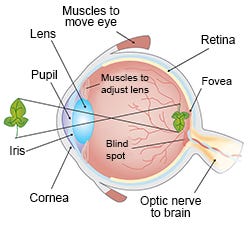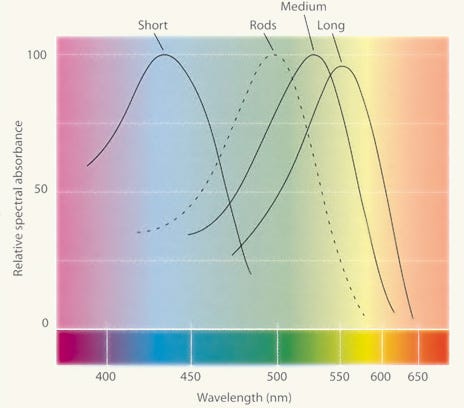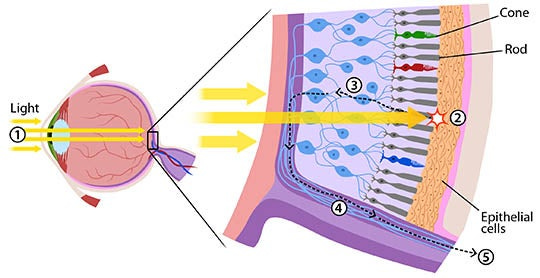https://www.science.org/doi/10.1126/sciadv.adu1052
"Is Your Red the Same as My Red?"
Long after Newton bent white light into its hidden hues, scientists have engineered color beyond nature’s capability all together.
The best discoveries and inventions are born of childhood curiosity.
I’m not the first to wonder: “Is your red the same as my red?” Surely many children have asked their parents the same. It’s hard to answer because it stretches from biology to philosophy, and now, into engineered perception.
Today, that curious question has a radical answer. And it starts at the back of your eye.
The Retina: Voting Booth of Vision
Inside the retina lie two kinds of light-sensing cells: rods and cones.
Rods are night vision agents—monochrome, exquisitely sensitive, but blind to color.
Cones come in three flavors:
S-cones (short wavelength): peak sensitivity at ~420 nm (blue)
M-cones (medium): ~534 nm (green)
L-cones (long): ~564 nm (red)
Yet cones don’t sense color directly. They merely respond to light. Their sensitivity curves overlap—sometimes significantly—so it’s the brain that interprets the relative activation between cone types.
Color is not detected.
It is inferred.
Yellow, for instance, isn’t “in” the light—it arises when L and M cones fire together. White appears when all three cones are triggered equally. What you see is not what is. Your brain is building reality from votes cast by cells.
What is Colorblindness?
Deuteranopia: M-cones gone—green dims or disappears.
Protanopia: L-cones absent—reds vanish into mud.
Tritanopia: Missing S-cones—blues shift or fade.
EnChroma lenses offer help—not by adding color, but by filtering the overlapping wavelengths, thus amplifying distinctions the brain can work with. It's not a cure. It's a tuning fork.
But what if, instead of clarifying perception, we crafted it?
Oz: The Retina as Canvas
This is where the revolution begins.
Oz is not a screen. It is not a display. It is a stimulator—a machine that activates individual cones directly, skipping wavelengths entirely.
Using pinpoint lasers, Oz fires micro-beams into a small retinal patch (~0.2°), tracking eye motion at 105 Hz and stimulating cones with millisecond pulses of green (543 nm) or blue (488 nm) light. Before it stimulates, Oz maps thousands of cones in the eye: identifying whether each is an L-, M-, or S-cone.
Then, with surgical precision, it triggers only the cones it chooses.
This isn’t just precise. It’s impossible by natural means. In nature, even laser light spreads and activates many cones. But Oz? It can light up 20 M-cones and leave the L-cones silent. Or hit 10 L- and 10 S-cones and avoid M-cones entirely.
There’s never been anything like this.
The Birth of Olo: A Color Without Precedent
In the lab, subjects were asked to match the colors they saw under Oz stimulation using a normal monitor.
Sometimes they could.
But sometimes... they couldn’t.
A particular stimulation—targeting L- and S-cones but skipping M-cones—produced a vivid sensation that simply didn’t exist in their projector’s gamut. The subjects had to desaturate the color to even describe it.
They called it olo.
“It felt like a blue-green,” said one, “but of impossible saturation.” Others found it sharp, uncanny, luminous. Not quite teal. Not quite turquoise. A color without coordinates in the natural world.
Because it wasn’t in the world.
It existed only inside the mind.
Why Olo Matters: Programmable Eyesight
Neuroscience Precision: Stimulate specific neural circuits. Paint signals directly onto the brain’s visual map.
Therapeutic Horizons: Imagine customizing vision for color-blind patients—crafting percepts uniquely tuned to their missing cones.
Sensory Expansion: Perceive the imperceptible. Use cone patterns to encode infrared data or UV warning signals.
Artistic Revolution: Artists might sculpt retinal experiences—private hues seen only by select eyes.
In a world where color is no longer passively seen but actively sculpted, a new frontier of perception awaits our discovery.
Perception as Craft: A New Kind of Vision
If Oz can create colors like olo, what else might we make?
Could an architect tint a room’s emotional signal by programming the occupants’ cone activations?
Could pilots perceive low-light obstacles not by night vision cameras, but by retinal overlays built from laser-coded cone ratios?
Could a child be taught new colors as easily as new words?
This is vision untethered from spectrum. The eye is no longer a passive lens—it’s a programmable interface.
Closing the Loop: The Question Reframed
We began with the child’s question: “Is your red the same as my red?”
Now we see, it never was.
Your cones are your own. Your brain’s decoding map is singular. But with Oz, we move beyond the question to ask ourselves: “What colors ought we invent together?”
Perception will no longer be bound. It is now something we can paint directly.
Not merely a window to reality
but a canvas for exploration.
Reflection:
If color is not only given, but a code we can read, write and rewrite, what else in our perception could be reprogrammed, not by accident or illusion, but through careful and intentional design?











